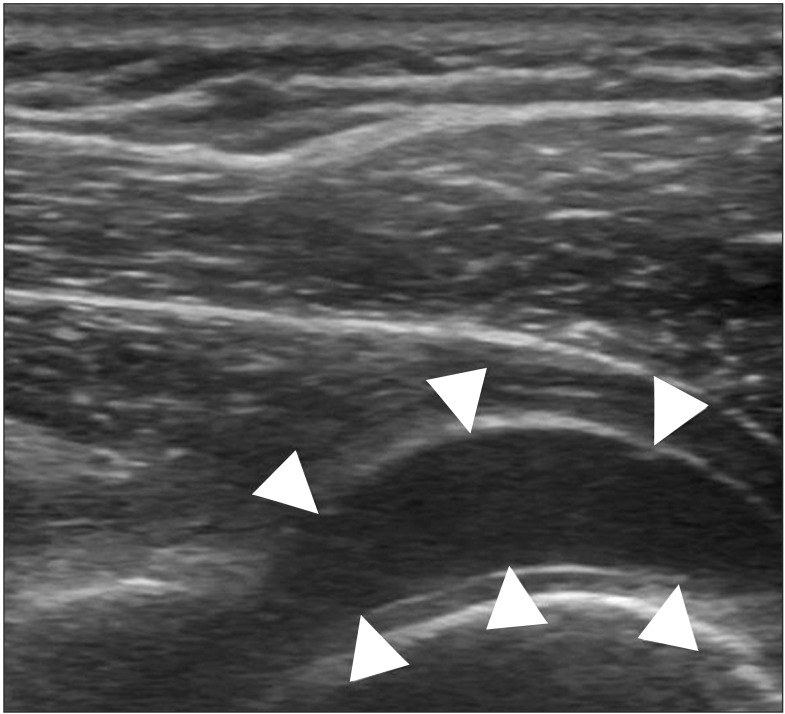Ann Rehabil Med.
2016 Jun;40(3):520-527. 10.5535/arm.2016.40.3.520.
Usefulness of a Hanging Position With Internal Rotation of Shoulder in Ultrasonography-Guided Intra-articular Steroid Injection for Adhesive Capsulitis
- Affiliations
-
- 1Department of Rehabilitation Medicine, Gyeongsang National University Hospital, Gyeongsang National University Graduate School of Medicine, Jinju, Korea.
- 2Department of Biomedical Engineering, Seoul National University College of Medicine, Seoul, Korea.
- 3Department of Rehabilitation Medicine, Seoul National University Boramae Medical Center, Seoul, Korea. ShiUk.Lee@gmail.com
- KMID: 2327615
- DOI: http://doi.org/10.5535/arm.2016.40.3.520
Abstract
OBJECTIVE
To evaluate the feasibility of a new position (internal rotation in hanging) in ultrasonography, we compared the length of the glenohumeral joint space and the effectiveness of steroid injection with the hanging position and with the commonly used abdomen or cross position.
METHODS
A prospective, randomized controlled trial was performed in 42 patients with adhesive capsulitis of shoulder. We used three arm positions for the posterior approach as follows: the patient's palm on thigh, other hand on abdomen (abdomen position); hand on patient's opposite shoulder (cross position); arm in hanging position with internal rotation of shoulder (hanging position). The order of shoulder position was randomized and blinded. Real-time ultrasonography-guided intra-articular steroid injection was performed by posterior approach at the first position in each patient. The Brief Pain Inventory (BPI), the Shoulder Pain and Disability Index (SPADI), and range of motion (ROM) were measured before steroid injection and 2 weeks after injection.
RESULTS
The lengths of the joint space were 2.88±0.75, 2.93±0.89, and 2.82±0.79 mm in abdomen, cross, and hanging position respectively, with no significant difference among the three positions (p=0.429). Treatment efficacy was significantly improved in ROM, total BPI, and SPADI in all three positions (p<0.001). The changes in ROM for shoulder abduction were 23.6°±19.7°, 22.2°±20.9°, and 10.0°±7.8° in abdomen, cross, and hanging position, respectively. Changes in total BPI scores were 25.1±15.7, 23.6.±18.0, 11.6±6.1, and changes in total SPADI score were 35.0±14.2, 30.9±28.9, and 16.5±10.3 in abdomen, cross, and hanging position, respectively. There were no significant difference among the three positions for all parameters (p=0.194, p=0.121, and p=0.108, respectively.
CONCLUSION
For patients with adhesive capsulitis who cannot achieve or maintain abdomen or cross position, scanning and injection with the shoulder in internal rotation with hanging position may be a useful alternative.
MeSH Terms
Figure
Reference
-
1. Grey RG. The natural history of "idiopathic" frozen shoulder. J Bone Joint Surg Am. 1978; 60:564. PMID: 670287.
Article2. Neviaser JS. Adhesive capsulitis and the stiff and painful shoulder. Orthop Clin North Am. 1980; 11:327–331. PMID: 7001312.
Article3. Binder AI, Bulgen DY, Hazleman BL, Roberts S. Frozen shoulder: a long-term prospective study. Ann Rheum Dis. 1984; 43:361–364. PMID: 6742896.
Article4. Murnaghan JP. Adhesive capsulitis of the shoulder: current concepts and treatment. Orthopedics. 1988; 11:153–158. PMID: 3281152.
Article5. Stitik TP, Foye PM, Fossati J. Shoulder injections for osteoarthritis and other disorders. Phys Med Rehabil Clin N Am. 2004; 15:407–446. PMID: 15145424.
Article6. Shah N, Lewis M. Shoulder adhesive capsulitis: systematic review of randomized trials using multiple corticosteroid injections. Br J Gen Pract. 2007; 57:662–667. PMID: 17688763.7. Valls R, Melloni P. Sonographic guidance of needle position for MR arthrography of the shoulder. AJR Am J Roentgenol. 1997; 169:845–847. PMID: 9275909.
Article8. Vierola H. Ultrasonography-guided contrast media injection to shoulder joint using a posterior approach: a technique worth trying. Acta Radiol. 2004; 45:616–617. PMID: 15587417.
Article9. Zwar RB, Read JW, Noakes JB. Sonographically guided glenohumeral joint injection. AJR Am J Roentgenol. 2004; 183:48–50. PMID: 15208107.
Article10. Neethling-du Toit M, de Villiers R. Anterior approach v. posterior approach-ultrasound-guided shoulder arthrogram injection. S Afr J Radiol. 2008; 12:60–62.11. Kim MW, Kim JS, Ko YJ, Lee WI, Kim JM, Yun JS. Ultrasonography guided glenohumeral injection using an anterior approach: a cadaveric study. J Korean Acad Rehabil Med. 2009; 33:215–218.12. Park KD, Nam HS, Kim TK, Kang SH, Lim MH, Park Y. Comparison of sono-guided capsular distension with fluoroscopically capsular distension in adhesive capsulitis of shoulder. Ann Rehabil Med. 2012; 36:88–97. PMID: 22506240.
Article13. Hannafin JA, Chiaia TA. Adhesive capsulitis. A treatment approach. Clin Orthop Relat Res. 2000; (372):95–109. PMID: 10738419.14. Breglio L. A system of orthopaedic medicine. J Hand Ther. 1996; 9:412–413.15. Tveita EK, Ekeberg OM, Juel NG, Bautz-Holter E. Range of shoulder motion in patients with adhesive capsulitis; intra-tester reproducibility is acceptable for group comparisons. BMC Musculoskelet Disord. 2008; 9:49. PMID: 18405388.
Article16. Tveita EK, Tariq R, Sesseng S, Juel NG, Bautz-Holter E. Hydrodilatation, corticosteroids and adhesive capsulitis: a randomized controlled trial. BMC Musculoskelet Disord. 2008; 9:53. PMID: 18423042.
Article17. Arslan S, Celiker R. Comparison of the efficacy of local corticosteroid injection and physical therapy for the treatment of adhesive capsulitis. Rheumatol Int. 2001; 21:20–23. PMID: 11678298.18. Yun YH, Mendoza TR, Heo DS, Yoo T, Heo BY, Park HA, et al. Development of a cancer pain assessment tool in Korea: a validation study of a Korean version of the brief pain inventory. Oncology. 2004; 66:439–444. PMID: 15452372.
Article19. Roach KE, Budiman-Mak E, Songsiridej N, Lertratanakul Y. Development of a shoulder pain and disability index. Arthritis Care Res. 1991; 4:143–149. PMID: 11188601.
Article20. Woodward TW, Best TM. The painful shoulder: part I. Clinical evaluation. Am Fam Physician. 2000; 61:3079–3088. PMID: 10839557.21. Tyler TF, Roy T, Nicholas SJ, Gleim GW. Reliability and validity of a new method of measuring posterior shoulder tightness. J Orthop Sports Phys Ther. 1999; 29:262–269. discussion 270-4. PMID: 10342563.
Article
- Full Text Links
- Actions
-
Cited
- CITED
-
- Close
- Share
- Similar articles
-
- The Effect of Intra-articular Steroid Injection for Adhesive Capsulitis in Spinal Cord Injured Patients
- Comparison of Intraarticular Steroid Injection with and without Capsular Distension in Adhesive Capsulitis of the Shoulder
- Comparison of Blind Technique and Ultrasonography Guided Technique of Intraarticular Injection of the Shoulder
- The Effect of Intraarticular Injection of Hyaluronic Acid and Steroid in Adhesive Capsulitis of Shoulder
- Treatment of Adhesive Capsulitis with Steroid Injection Followed by Hyaluronic Acid Injection





